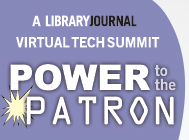 As part of the preparation for the upcoming LJ Virtual Tech Summit on December 8, The Digital Shift has been featuring interviews with some of the panelists (including Darien Library’s Gretchen Caserotti and Brigham Young University’s Michael Whitchurch).
As part of the preparation for the upcoming LJ Virtual Tech Summit on December 8, The Digital Shift has been featuring interviews with some of the panelists (including Darien Library’s Gretchen Caserotti and Brigham Young University’s Michael Whitchurch).
Most recently, LJ touched base with Nate Hill, web librarian at San José Public Library (SJPL), CA, to discuss mobile tech in libraries.
LJ: In 2009, you wrote a piece for LJ addressing one potential use of QR codes in libraries. Where do you think QR codes are headed?
Hill: The 2009 LJ article was about a (now defunct) project called “Greenpoint Poetry Sites.” We placed stickers with QR codes around the Greenpoint, Brooklyn, neighborhood, each of which was linked to an open WordPress blog. Users were then encouraged to engage in writing a site-specific community poem on their phones.
If I were to do a QR code project at a library now, I’d be thinking about how I could directly link from the code to an ebook. I think it’d be interesting to make some beautiful, book-sized acrylic or wooden blocks with QR codes on them linking to the text, and I’d interfile those acrylic or wooden blocks on the shelf appropriately with the other books. If, for example, all of the physical copies of The Adventures of Huckleberry Finn were checked out but I had a school project to do and really needed to read it, I’d find the QR code on the shelf where the book would have been and then I could access it that way. As library shelves become emptier and we buy/lease/make more digital content, this could be a nice way to transition between the physical and digital library spaces.
You spearheaded a major redesign of the SJPL site, which went live about a year ago. The simplified design of the homepage is similar to the bare-bones style of many mobile library websites. Was mobile access a consideration?
Yes, I’d say that thinking mobile was a part of the design process, but perhaps not in the way you might guess. There was a great deal of thought and testing that informed the reductive approach to the new home page, and because of our process we achieved a somewhat minimalist user interface. Since then it’s become fashionable to design for small mobile screens first and desktop displays second, so this tough, reductive approach is increasingly common. I guess I’d call it a case of parallel results with similar intentions. The good news is that we’ll be able to make the next version of the site far more responsive to different devices without too much friction for the end user.
What mobile trends do you think will gain traction in libraries?
I’m impressed with Denver Public Library’s Creating Communities project. I think Historypin is a pretty fantastic product as well, and libraries could do a lot with it. On the whole, there’s an interesting future for libraries doing location specific mobile projects. By associating knowledge and resources with their point of origin for display and interaction we take our collections out of our buildings and give them a new, lively context.
 Library Journal’s one-day Virtual Tech Summit on Dec. 8, Power to the Patron: From Systems to Services, will examine technologies that empower library users and the behind-the scenes systems that make them possible. Get more information and register at www.thedigitalshift.com/events/tech-summit/.
Library Journal’s one-day Virtual Tech Summit on Dec. 8, Power to the Patron: From Systems to Services, will examine technologies that empower library users and the behind-the scenes systems that make them possible. Get more information and register at www.thedigitalshift.com/events/tech-summit/.


re: “I’d be thinking about how I could directly link from the code to an ebook… linking to the text, …If, for example, all of the physical copies of The Adventures of Huckleberry Finn were checked out…”
you can do this right now. you can either use the Project Gutenberg QR codes (or if you have Overdrive, create some codes) to link to the books or put a short amount of text right into the QR code, like a poem or a short paragraph. make the beautiful dummy book and put the code on it, the codes are already done. .. but it would be cool if Gutenberg had a project where we could make custom codes that went directly to a specific passage within an ebook, but you’d have to be able to edit the book somehow with a target for each code… not likely with the thousands of codes some books might inspire.
Effinglibrarian, you are missing the point. Of course you can link directly to ebooks from a QR code now. The point is that we could make the ebook discoverable in order on the physical shelf.
I thought that’s what I said, “make the beautiful dummy book and put the code on it, the codes are already done.”
put your dummy book on the shelf next to the physical book with the code on it. — isn’t that what we’re talking about?
heh. totally. poor reading skills on my part, I misunderstood. sorry!